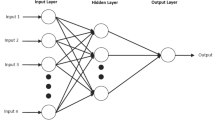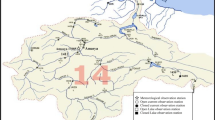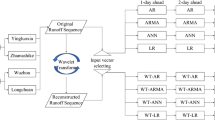Abstract
Long-term monthly streamflow forecasting has great importance in the water resource system planning. However, its modelling in extreme cases is difficult, especially in semiarid regions. The main purpose of this paper is to evaluate the accuracy of artificial neural networks (ANNs) and hybrid wavelet-artificial neural networks (WA-ANNs) for multi-step monthly streamflow forecasting in two different hydro-climatic regions in Northern Algeria. Different issues have been addressed, both those related to the model’s structure and those related to wavelet transform. The discrete wavelet transform has been used for the preprocessing of the input variables of the hybrid models, and the multi-step streamflow forecast was carried out by means of a recursive approach. The study demonstrated that WA-ANN models outperform the single ANN models for the two hydro-climatic regions. According to the performance criteria used, the results highlighted the ability of WA-ANN models with lagged streamflows, precipitations and evapotranspirations to forecast up to 19 months for the humid region with good accuracy [Nash–Sutcliffe criterion (Ns) equal 0.63], whereas, for the semiarid region, the introduction of evapotranspirations does not improve the model’s accuracy for long lead time (Ns less than 0.6 for all combinations used). The maximum lead time achieved, for the semiarid region, was about 13 months, with only lagged streamflows as inputs.








Similar content being viewed by others
References
Abda Z, Chettih M (2018) Forecasting daily flow rate-based intelligent hybrid models combining wavelet and Hilbert–Huang transforms in the mediterranean basin in northern Algeria. Acta Geophys. https://doi.org/10.1007/s11600-018-0188-0
Addison PS (2002) The illustrated wavelet handbook: introduction theory and applications in science, engineering, medicine and finance. IOP Publishing Ltd
Adamowski J, Sun K (2010) Development of a coupled wavelet transform and neural network method for flow forecasting of non-perennial rivers in semiarid watersheds. J Hydrol 390:85–91
Akrami SA, El-Shafie A, Naseri M, Santos CAG (2014) Rainfall data analyzing using moving average (MA) model and wavelet multi-resolution intelligent model for noise evaluation to improve the forecasting accuracy. Neural Comput Appl 25:1853–1861
Balkin SD, Ord JK (2000) Automatic neural network modeling for univariate time series. Int J Forecast 16:509–515
Baratti R, Cannas B, Fanni A, Pintus M, Sechi GM, Toreno N (2003) River flow forecast for reservoir management through neural networks. Neurocomputing 55(3):421–437
Burden F, Winkler D (2008) Bayesian regularization of neural networks. In: Livingstone DS (ed) Artificial neural networks: methods in molecular biology™, vol 458. Humana Press. https://doi.org/10.1007/978-1-60327-101-1_3
Chiew FHS, McMahon TA (2002) Global ENSO-streamflow teleconnection, streamflow forecasting and interannual variability. Hydrol Sci J 47(3):505–522
Danadeh Mehr A, Kahya E, Şahin A, Nazemosadat MJ (2014) Successive-station monthly streamflow prediction using different artificial neural network algorithms. Int J Environ Sci Technol 12:2191–2200
Danandeh Mehr A, Kahya E, Şahin A, Nazemosadat MJ (2015) Successive-station monthly streamflow prediction using different artificial neural network algorithms. Int J Environ Sci Technol 12(7):2191–2200
Daubechies I (1992) Ten lectures on wavelets. In: CSBM-NSF series on applied mathematics, vol 61. SIAM Publication
Djerbouai S, Souag-Gamane D (2016) Drought forecasting using neural networks, wavelet neural networks, and stochastic models: case of Algerois Basin in North Algeria. Water Resour Res. https://doi.org/10.1007/s11269-016-1298-6
Dunne T (1983) Relation of field studies and modeling in the prediction of storm runoff. J Hydrol 65:25–48
Foresee D, Hagan MT (1997) Gauss-Newton approximation to Bayesian learning. In: Proceedings of the 1997 international joint conference on neural networks, vol 3, pp 1930–1935
Geman S, Bienenstock E, Dourast R (1992) Neural networks and the bias/variance dilemma. Neural Comput 04:1–58
Hadi SJ, Tombul M (2018a) Streamflow forecasting using four wavelet transformation combinations approaches with data-driven models: a comparative study. Water Resour Manag. https://doi.org/10.1007/s11269-018-2077-3
Hadi SJ, Tombul M (2018b) Monthly streamflow forecasting using continuous wavelet and multi-gene genetic programming combination. J Hydrol 561:674–687
He Z, Zhang Y, Guo Q, Zhao X (2014) Comparative study of artificial neural networks and wavelet artificial neural networks for groundwater depth data forecasting with various curve fractal dimensions. Water Resour Manag 28:5297–5317. https://doi.org/10.1007/s11269-014-0802-0
Ji Y, Hao J, Reyhani N, Lendasse A (2005) Direct and recursive prediction of time series using mutual information selection neural network. Lect Notes Comput Sci 3512:1010–1017
Karran DJ, Morin E, Adamowski J (2014) Multi-step streamflow forecasting using data-driven non-linear methods in contrasting climate regimes. J Hydroinform 16:671–689
Kayri M (2016) Predictive abilities of bayesian regularization and Levenberg–Marquardt algorithms in artificial neural networks: a comparative empirical study on social data. Math Comput Appl 21:20
Kisi O (2008) Streamflow forecasting using neuro-wavelet technique. Hydrol Process 22:4142–4152
Kisi O (2009) Neural networks and wavelet conjunction model for intermittent streamflow forecasting. J Hydrol Eng 14(8):773–782
Kisi O, Cigizoglu HK (2007) Comparison of different ANN techniques in river flow prediction. Civ Eng Environ Syst 24:211–231
Kisi O, Cimen M (2011) A wavelet-support vector machine conjunction model for monthly streamflow forecasting. J Hydrol 399:132–140
Kisi O, Partal T (2011) Wavelet and neuro-fuzzy conjunction model for streamflow forecasting. Hydrol Res 42:447–456
Labat D (2005) Recent advances in wavelet analyses: part 1. A review of concepts. J Hydrol 314:275–288
Labat D, Ababou R, Mangin A (2000) Rainfall–runoff relations for karstic springs. part II: continuous. J Hydrol 248:149–278
Legates DR, McCabe GJ Jr (1999) Evaluating the use of “goodness-of-fit” measures in hydrologic and hydroclimatic model validation. Water Resour Res 35:233–241
Maheswaran R, Khosa R (2012) Comparative study of different wavelets for hydrologic forecasting. Comput Geosci 46:284–295
Makwanana JJ, Tiwari MK (2014) Intermittent streamflow forecasting and extreme event modelling using wavelet based artificial neural networks. Water Resour Res 28:4857–4873
Mallat SG (1989) A theory for multiresolution signal decomposition: the wavelet representation. IEEE Trans Pattern Anal Mach Intell 11: 674–693. https://doi.org/10.1109/34.192463
Nalley D, Adamowski J, Khalil B (2012) Using discrete wavelet transforms to analyze trends in streamflow and precipitation in Quebec and Ontario (1954–2008). J Hydrol 475:204–228
Nash JE, Sutcliffe JV (1970) River flow forecasting through conceptual models part I—a discussion of principles. J Hydrol 10:282–290
Nason G, Sachs R, Krois G (2000) Wavelet processes and adaptive estimation of the evolutionary wavelet spectrum. J R Stat Soc B 62:271–292
Nourani V, Komasi M, Mano A (2009) A multivariate ANN-wavelet approach for rainfall–runoff modeling. Water Resour Manag 23:2877–2894
Nourani V, Kisi O, Komasi M (2011) Two hybrid artificial intelligence approaches for modeling rainfall–runoff process. J Hydrol 402:41–59
Nourani V, BagahnamA Adamowski J, Kisi O (2014) Applications of hybrid wavelet-artificial intelligence models in hydrology: a review. J Hydrol 514:358–377
Pagano TC, Garen DC, Perkins TR, Pasteris PA (2009) Daily updating of operational statistical seasonal water supply forecasts for the western US. J Am Water Resour Assoc 45:767–778
Partal T, Küçük M (2006) Long-term trend analysis using discrete wavelet components of annual precipitations measurements in Marmara region (Turkey). Phys Chem Earth 31:1189–1200
Percival DB (2008) Analysis of geophysical time series using discrete wavelet transforms: an overview. In: Donner RV, Barbosa SM (eds) Nonlinear time series analysis in the geosciences–applications in climatology, geodynamics, and solar-terrestrial physics, vol 112, pp 61–79
Robertson DE, Wang QJ (2012) A Bayesian approach to predictor selection for seasonal streamflow forecasting. J Hydrometeorol. https://doi.org/10.1175/JHM-D-10-05009.1
Rogers WF (1982) Some characteristics and implications of drainage basin linearity and nonlinearity. J Hydrol 55:247–265
Sang YF (2012) A practical guide to discrete wavelet decomposition of hydrologic time series. Water Resour Manag 26:3345–3365
Santos CAG, Silva GBL (2014) Daily streamflow forecasting using a wavelet transform and artificial neural network hybrid models. Hydrol Sci J 59:1–13
Santos CAG, Freire PKMM, Silva GBL, Silva RM (2014) Discrete wavelet transform coupled with ANN for daily discharge forecasting into Três Marias reservoir. Proc Int Assoc Hydrol Sci 364:100–105
Seo Y, Kim S, Kisi O, Singh VP (2015) Daily water level forecasting using wavelet decomposition and artificial intelligence techniques. J Hydrol 520:224–243. https://doi.org/10.1016/j.jhydrol.2014.11.050
Shoaib M, Shamseldin AY, Melville BW (2014) Comparative study of different wavelet based neural network models for rainfall–runoff modelling. J Hydrol 515:47–58
Shoaib M, Shamseldin AY, Khan S, Khan MM, Khan ZM, Sultan T, Melville BW (2017) A comparative study of various hybrid wavelet feed forward neural network models for runoff forecasting. Water Resour Res. https://doi.org/10.1007/s11269-017-1796-1
Sun AY, Wang D, Xu X (2014) Monthly streamflow forecasting using Gaussian process regression. J Hydrol 511:72–81
Toth E, Brath A (2007) Multistep ahead streamflow forecasting: role of calibration data in conceptual and neural network modelling. Water Resour Res. https://doi.org/10.1029/2006WR005383
Van Ogtrop FF, Vervoort RW, Heller GZ, Stasinopoulos DM, Rigby RA (2011) Long-range forecasting of intermittent streamflow. Hydrol Earth Syst Sci 15:3343–3354
Wang D, Wu L (2012) Similarity between runoff coefficient and perennial stream density in the Budyko framework. Hydrol Earth Syst Sci 09:7571–7589
Wang W, Van Gelder Pieter HAJM, Vrijlingb JK, Mac Jun (2006a) Forecasting daily streamflow using hybrid ANN models. J Hydrol 324:383–399
Wang W, Vrijling JK, Van Gelder PHAJM, Ma J (2006b) Testing for nonlinearity of streamflow processes at different timescales. J Hydrol 322:247–268
Wei S, Yang H, Song J, Abbaspour K, Xu Z (2014) A wavelet-neural network hybrid modelling approach for estimating and predicting river monthly flows. Hydrol Sci J. https://doi.org/10.1080/02626667.2012.754102
Williams JR, Amaratunga K (1994) Introduction to wavelets in engineering. Int J Numer Methods Eng 37:2365–2388
Xiaoyu L, Bing WK, Simon YF (1999) Time series prediction based on fuzzy principles. Department of Electrical and Computer Engineering, FAMU-FSU College of Engineering, Florida State University, Tallahassee, FL 32310
Yonaba H, Anctil F, Fortin V (2010) Comparing sigmoid transfer functions for neural network multistep ahead streamflow forecasting. J Hydrol Eng 15:275–283
Zakhrouf M, Bouchelkia H, Stamboul M, Kim S, Heddam S (2018) Time series forecasting of river flow using an integrated approach of wavelet multi-resolution analysis and evolutionary data-driven models. A case study: Sebaou river (Algeria). Phys Geogr. https://doi.org/10.1080/02723646.2018.1429245
Zhang GP, Patuwo BE, Hu MY (1998) Forecasting with artificial neural networks: the state of the art. Int J Forecast 14:35–62
Author information
Authors and Affiliations
Corresponding author
Rights and permissions
About this article
Cite this article
Fouchal, A., Souag-Gamane, D. Long-term monthly streamflow forecasting in humid and semiarid regions. Acta Geophys. 67, 1223–1240 (2019). https://doi.org/10.1007/s11600-019-00312-3
Received:
Accepted:
Published:
Issue Date:
DOI: https://doi.org/10.1007/s11600-019-00312-3




